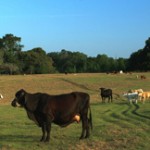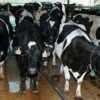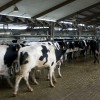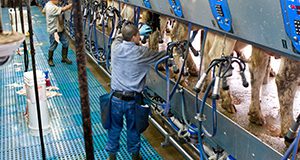In the Southeast, milk is priced based on fat and skim milk value, with additional bonuses for somatic cell and bacterial counts. In recent years, butterfat has become more valuable. This 7-page document discusses some of the history behind the changes in milk fat consumption, management factors that influence milk fat content and yield by dairy cattle, and economic implications of changing fat content through the diet in two case scenarios. Written by José E. P. Santos and Albert De Vries, and published by the UF/IFAS Department of Animal Sciences, January 2019.
http://edis.ifas.ufl.edu/an350
Tag: Jose E.P. Santos
What Is the Most Cost-Effective Breeding Program for Lactating Dairy Cows: Timed AI, Estrous Detection, or a Combination of Both?
 As any other business enterprise, the sustainability of a dairy farm is highly dependent on economics. Reproduction influences both milk production and number of replacement heifers available on a farm; therefore, reproductive efficiency becomes a key determinant of dairy cow profitability. Several parameters affect reproductive performance. This 4-page fact sheet presents information from recently published articles that looked at the economics of different reproductive programs for breeding dairy cows that use estrus detection only, timed AI only, or a combination of both. Written by Klibs N. Galvão, Gustavo M. Schuenemann, Eduardo S. Ribeiro, and Jose Eduardo P. Santos, and published by the UF Department of Veterinary Medicine-Large Animal Clinical Sciences, May 2014.
As any other business enterprise, the sustainability of a dairy farm is highly dependent on economics. Reproduction influences both milk production and number of replacement heifers available on a farm; therefore, reproductive efficiency becomes a key determinant of dairy cow profitability. Several parameters affect reproductive performance. This 4-page fact sheet presents information from recently published articles that looked at the economics of different reproductive programs for breeding dairy cows that use estrus detection only, timed AI only, or a combination of both. Written by Klibs N. Galvão, Gustavo M. Schuenemann, Eduardo S. Ribeiro, and Jose Eduardo P. Santos, and published by the UF Department of Veterinary Medicine-Large Animal Clinical Sciences, May 2014.
http://edis.ifas.ufl.edu/vm198
What Is the Most Cost-Effective Breeding Program for Breeding Heifers: Timed AI, Estrous Detection, or a Combination of Both?
 As any other business enterprise, the sustainability of a dairy farm is highly dependent on economics. In order to obtain a profitable return on assets, there is a constant need to maximize outputs and, oftentimes, to minimize inputs. Reproduction influences both milk production and number of replacement heifers available on a farm; therefore, reproductive efficiency becomes a key determinant of dairy cow profitability. This 3-page fact sheet presents information from recently published work that looked at the economics of different reproductive programs for breeding heifers that use timed AI only, estrus detection only, or a combination of both. Written by Klibs N. Galvão, Eduardo S. Ribeiro, and Jose Eduardo P. Santos, and published by the UF Department of Veterinary Medicine-Large Animal Clinical Sciences, May 2014.
As any other business enterprise, the sustainability of a dairy farm is highly dependent on economics. In order to obtain a profitable return on assets, there is a constant need to maximize outputs and, oftentimes, to minimize inputs. Reproduction influences both milk production and number of replacement heifers available on a farm; therefore, reproductive efficiency becomes a key determinant of dairy cow profitability. This 3-page fact sheet presents information from recently published work that looked at the economics of different reproductive programs for breeding heifers that use timed AI only, estrus detection only, or a combination of both. Written by Klibs N. Galvão, Eduardo S. Ribeiro, and Jose Eduardo P. Santos, and published by the UF Department of Veterinary Medicine-Large Animal Clinical Sciences, May 2014.
http://edis.ifas.ufl.edu/vm199
Is It Worth Switching from Natural Service to Artificial Insemination? A Comparison of Reproductive Performance and Profitability in Dairy Herds
 Reproductive efficiency is a key determinant of dairy cow profitability. A considerable portion of dairy producers in the United States still use NS in at least part of their breeding program. This 3-page fact sheet presents the results of papers that compared the reproductive performance and profitability of dairy cows submitted to natural service or a combination of timed AI and natural service. Written by Klibs N. Galvão, Eduardo S. Ribeiro, and Jose Eduardo P. Santos, and published by the UF Department of Veterinary Medicine-Large Animal Clinical Sciences, June 2014.
Reproductive efficiency is a key determinant of dairy cow profitability. A considerable portion of dairy producers in the United States still use NS in at least part of their breeding program. This 3-page fact sheet presents the results of papers that compared the reproductive performance and profitability of dairy cows submitted to natural service or a combination of timed AI and natural service. Written by Klibs N. Galvão, Eduardo S. Ribeiro, and Jose Eduardo P. Santos, and published by the UF Department of Veterinary Medicine-Large Animal Clinical Sciences, June 2014.
http://edis.ifas.ufl.edu/vm200
Importance of Milk Feeding Pre-weaning to Dairy Calves (AN263)
 Similar to any mammal, newborn dairy calves must consume milk in the first weeks of life because of their inability to properly digest dry feeds. On most dairy farms, milk harvested from cows or reconstituted milk replacer powder provides the primary source of nutrients for calves in the first 4–6 weeks of life before they are able to adequately digest other feeds. This 4-page fact sheet was written by Milerky C. Perdomo and José E.P. Santos, and published by the UF Department of Animal Science, June 2011. (AP photo by Tara Piasio/University of Florida/IFAS)
Similar to any mammal, newborn dairy calves must consume milk in the first weeks of life because of their inability to properly digest dry feeds. On most dairy farms, milk harvested from cows or reconstituted milk replacer powder provides the primary source of nutrients for calves in the first 4–6 weeks of life before they are able to adequately digest other feeds. This 4-page fact sheet was written by Milerky C. Perdomo and José E.P. Santos, and published by the UF Department of Animal Science, June 2011. (AP photo by Tara Piasio/University of Florida/IFAS)
http://edis.ifas.ufl.edu/an263
Management of Reproduction in Dairy Herds with Natural Service or Timed Artificial Insemination (AN262)
 Both natural service and artificial insemination programs can work for managing reproduction on dairy farms. This 3-page fact sheet provides comparison of reproductive performance and economic considerations. Written by Fábio S. Lima, Albert De Vries, Carlos A. Risco, and José E.P. Santos, and published by the UF Department of Animal Science, June 2011. (UF/IFAS Photo: Thomas Wright)
Both natural service and artificial insemination programs can work for managing reproduction on dairy farms. This 3-page fact sheet provides comparison of reproductive performance and economic considerations. Written by Fábio S. Lima, Albert De Vries, Carlos A. Risco, and José E.P. Santos, and published by the UF Department of Animal Science, June 2011. (UF/IFAS Photo: Thomas Wright)
http://edis.ifas.ufl.edu/an262
Understanding and Troubleshooting Milk Fat Depression in Dairy Herds (AN261)
 Sometimes energy-rich diets formulated to maximize milk production exert negative effects on milk fat. This 4-page fact sheet reviews some of the dietary factors that induce milk fat depression and explains how to troubleshoot this problem. Written by Leandro F. Greco and José E.P. Santos, and published by the UF Department of Animal Science, June 2011. (AP photo/University of Florida/IFAS/Josh Wickham)
Sometimes energy-rich diets formulated to maximize milk production exert negative effects on milk fat. This 4-page fact sheet reviews some of the dietary factors that induce milk fat depression and explains how to troubleshoot this problem. Written by Leandro F. Greco and José E.P. Santos, and published by the UF Department of Animal Science, June 2011. (AP photo/University of Florida/IFAS/Josh Wickham)
http://edis.ifas.ufl.edu/an261
Identifying and Treating Uterine Disease in Dairy Cows (VM179)
Uterine diseases are prevalent in high producing dairy cows and require prompt diagnosis and treatment. This 6-page fact sheet describes identification and treatment for four classes of uterine diseases in dairy cows. Written by Klibs N. Galvão, Carlos Risco, and Jose E.P. Santos, and published by the UF Department of Veterinary Medicine, May 2011.
http://edis.ifas.ufl.edu/vm179
